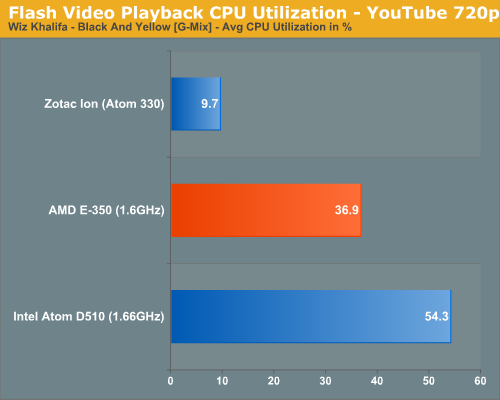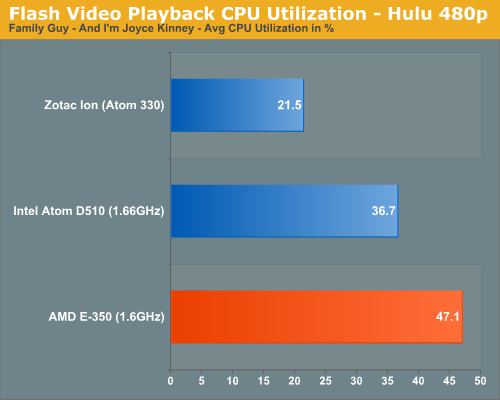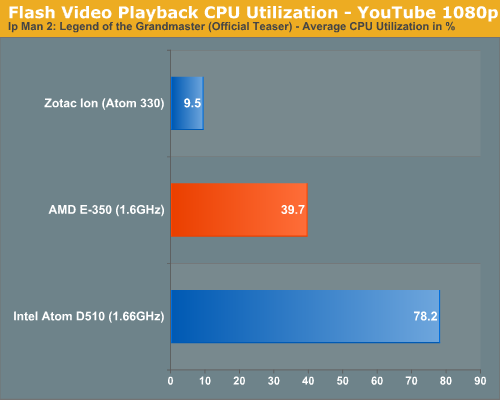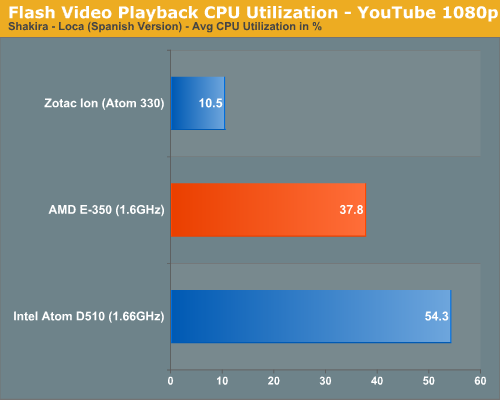The Brazos Review: AMD's E-350 Supplants ION for mini-ITX
by Anand Lal Shimpi on January 27, 2011 6:08 PM ESTBlu-ray & Flash Video Acceleration
Compatibility is obviously a strongpoint of Brazos. So long as what you’re decoding can be hardware accelerated you’re pretty much in the clear. But what about CPU utilization while playing back these hardware accelerated formats? The CPU still needs to feed data to the GPU, how many cycles are used in the process?
I fired up a few H.264/x264 tests to kick off the investigation. First we have a 1080p H.264 Blu-ray rip of Quantum of Solace, averaging around 15Mbps:
| Quantum of Solace 1080p H.264 CPU Utilization (1:00 - 1:30) | |||||
| Platform | Min | Avg | Max | ||
| AMD E-350 | 22.7% | 27.8% | 35.3% | ||
| Intel Atom D510 | Fail | ||||
| Zotac ION | 14.6% | 17.2% | 20.1% | ||
A standard Atom platform can’t decode the video but ION manages a 17% average CPU utilization with an Atom 330. Remember that the Atom 330 is a dual-core CPU with SMT (4-threads total) so you’re actually getting 17.2% of four hardware threads used, but 34.4% of two cores. The E-350 by comparison leaves 27.8% of its two cores in use during this test. Both systems have more than enough horsepower left over to do other things.
Next up is an actual Blu-ray disc (Casino Royale) but stripped of its DRM using AnyDVD HD and played back from a folder on the SSD:
| Casino Royale BD (no DRM) CPU Utilization (49:00 - 49:30) | |||||
| Platform | Min | Avg | Max | ||
| AMD E-350 | 28.1% | 33.0% | 38.4% | ||
| Intel Atom D510 | Fail | ||||
| Zotac ION | 17.7% | 22.5% | 27.5% | ||
Average CPU utilization here for the E-350 was 33% of two cores.
Finally I ran a full blown Blu-ray disc (Star Trek) bitstreaming TrueHD on the E-350 to give you an idea of what worst case scenario CPU utilization would be like on Brazos:
| Star Trek BD CPU Utilization (2:30 - 3:30) | |||||
| Platform | Min | Avg | Max | ||
| AMD E-350 | 29.0% | 40.1% | 57.1% | ||
At 40% CPU utilization on average there’s enough headroom to do something else while watching a high bitrate 1080p movie on Brazos. The GPU based video decode acceleration does work, however the limits here are clear. Brazos isn’t going to fare well as a platform you use for heavy multitasking while decoding video, even if the video decode is hardware accelerated. As a value/entry-level platform I doubt this needs much more explanation.
Now let’s talk about Flash.
I ran through a number of Flash video tests at both YouTube and Hulu ranging in resolution from 480p all the way up to 1080p. I used Flash 10.1, 10.2 beta as well as an unreleased version of 10.2 beta provided by AMD.


For the most part GPU accelerated Flash video does work well. Performance under both YouTube and Hulu was flawless, provided that I wasn’t watching 1080p content. Watching 1080p content in YouTube wasn’t entirely smooth on Brazos, despite posting very reasonable CPU utilization numbers.


I took my concerns to AMD and was told that this was a known issue with Brazos and Flash 10.1 and that 10.2 should alleviate the issue. AMD then supplied me with an unreleased version of Flash 10.2 to allow me to verify its claims. While 1080p playback improved with AMD’s 10.2 beta, it wasn’t perfect (although it was very close). AMD wouldn’t tell me the cause of the problem but it’s currently working on it with Adobe. At the end of the day I don’t believe it’s a dealbreaker, but early Brazos adapters should expect some stuttering when playing back 1080p YouTube videos. Note that 720p and lower resolution videos were perfectly smooth on Brazos.










176 Comments
View All Comments
themw6 - Saturday, January 29, 2011 - link
Hi Anand, as many of us are interested in using zacate in a NAS - could you run a quick truecrypt benchmark? I'm especially interested in AES-256 performance. Additionally, network throughput would be great, too ;)Something else: you measured 24 watts idle power consumption. Could you provide more details on your test platform? Others had engineering samples with as little as 11 watts at idle. I'm guessing you used some 850W-rated PSU? ;) Anyway, thanks for the review!
MrSpadge - Saturday, January 29, 2011 - link
With such a low clock speed and such low power draw and a desktop platform, which can easily provide power but needs some more performance.. you'd think AMD would have put a proper Turbo mode in there. 1 thread 2.0 GHz, 2 threads 1.6 GHz - easy.MrS
rashire - Saturday, January 29, 2011 - link
First Thanks to Anand for doing a HTPC review for this chip, I've been waiting on this since your initial comments in Nov.But I'm kind of disappointed after reading the review. While it definitely looks like a better alternative to atom+ion i was just expecting a bit more horse power from it.
I was hoping for a product i was certain would have the power to do downloads, archive extraction and other CPU intensive processes in the background while doing 1080p playback or running an emulator in the foreground. And from the review i just don't see enough power to be sure my media and data-storage processes without potentially maxing out the CPU under certain combinations.
Looking forward to next gen discrete solution to replace my mid-tower HTPC.
GullLars - Sunday, January 30, 2011 - link
I'd like to see a clock for clock comparison of Bobcat, Athlon II, Phenom II, Atom, Core, Nehalem, and Sandy Bridge.From what i can see in these graphs, Bobcat performs about 60-90% of Athlon II clock for clock.
I look forward to seeing overclocking of bobcat :)
Malih - Sunday, January 30, 2011 - link
Zacate (board) ~$100WiFi ~$25
small Case ~$75
PSU ~$50
4GB RAM ~$50
widescreen LCD ~$125
storage ~$100
around $500 for a good enough complete system, but of course you can always get cheaper case, PSU, storage, LCD and 2GB RAM
THE_DOM!NAT0R - Monday, January 31, 2011 - link
The mini-ITX boards based on Brazos are quite good as it seems. They surpass Atom for HTPC's and have more features like more sata ports. I would like to see a comparison with about 5 mini-itx Brazos boards by Anand. Also, if you have a power supply that is rated for max efficiency at about 15-30 W, you can accurately compare the power figures between Brazos boards and Atom. I've seen some reviews and they use power supplies that are rated at about 300W; their lowest reasonable efficiency is 10% load, that isn't designed for 15<P<30.MrMilli - Monday, January 31, 2011 - link
I would really like to see a comparison against the Athlon II 250u.jamesgor13579 - Monday, January 31, 2011 - link
Until it can replace my ION/Linux/XBMC system, I am not interested. AMD has been doing well on the Linux front recently, but I don't know about their video decode.Metaluna - Monday, January 31, 2011 - link
I'm also interested in how these boards perform in Linux (or even if the new GPU is supported at all in current mainstream distros like Ubuntu 10.10). I'm interested in building a small nettop, mostly for web browsing but possibly HTPC use at some point.Jeffk464 - Tuesday, February 1, 2011 - link
"The good news is 1080i60 works just fine.Brazos’ GPU also fails all of our deinterlacing tests,"
The second sentence follows the first one and seems to directly contradict it. I was planning on buying one of these for a htpc and the ability to play 1080i60 as well as 1080p24 are absolutely critical. 1080i60 is one of the main standards of broadcast(over the air TV) and 1080p24 is the standard for blue ray. So my question then becomes since the author seems to have contradicted himself can brazos handle the interlaced 1080i60 content? This article should have cleared things up not made it more confusing.